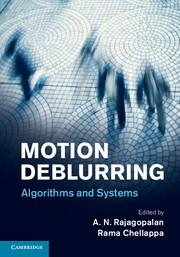Book contents
- Frontmatter
- Contents
- List of contributors
- Preface
- 1 Mathematical models and practical solvers for uniform motion deblurring
- 2 Spatially-varying image deblurring
- 3 Hybrid-imaging for motion deblurring
- 4 Efficient, blind, spatially-variant deblurring for shaken images
- 5 Removing camera shake in smartphones without hardware stabilization
- 6 Multi-sensor fusion for motion deblurring
- 7 Motion deblurring using fluttered shutter
- 8 Richardson–Lucy deblurring for scenes under a projective motion path
- 9 HDR imaging in the presence of motion blur
- 10 Compressive video sensing to tackle motion blur
- 11 Coded exposure motion deblurring for recognition
- 12 Direct recognition of motion-blurred faces
- 13 Performance limits for motion deblurring cameras
- Index
- References
5 - Removing camera shake in smartphones without hardware stabilization
Published online by Cambridge University Press: 05 June 2014
- Frontmatter
- Contents
- List of contributors
- Preface
- 1 Mathematical models and practical solvers for uniform motion deblurring
- 2 Spatially-varying image deblurring
- 3 Hybrid-imaging for motion deblurring
- 4 Efficient, blind, spatially-variant deblurring for shaken images
- 5 Removing camera shake in smartphones without hardware stabilization
- 6 Multi-sensor fusion for motion deblurring
- 7 Motion deblurring using fluttered shutter
- 8 Richardson–Lucy deblurring for scenes under a projective motion path
- 9 HDR imaging in the presence of motion blur
- 10 Compressive video sensing to tackle motion blur
- 11 Coded exposure motion deblurring for recognition
- 12 Direct recognition of motion-blurred faces
- 13 Performance limits for motion deblurring cameras
- Index
- References
Summary
Introduction
Processing images has become an everyday practice in a wide range of applications in science and technology and we rely on our images with ever growing emphasis. Our understanding of the world is however limited by measuring devices that we use to acquire images. Inadequate measuring conditions together with technological limitations of the measuring devices result in acquired images that represent a degraded version of the “true” image.
Blur induced by camera motion is a frequent problem in photography – mainly when the light conditions are poor. As the exposure time increases, involuntary camera motion has a growing effect on the acquired image. Image stabilization (IS) devices that help to reduce the motion blur by moving the camera sensor in the opposite direction are becoming more common. However, such a hardware remedy has its limitations as it can only compensate for motion of a very small extent and speed. Deblurring the image offline using mathematical algorithms is usually the only choice we have to obtain a sharp image. Motion blur can be modeled by convolution and the deblurring process is called deconvolution, which is a well-known ill-posed problem. In general, the situation is even more complicated, since we usually have no or limited information about the blur shape.
We can divide the deconvolution methods into two categories: methods that estimate the blur and the sharp image directly from the acquired image (blind deconvolution), and methods that use information from other sensors to estimate the blur (semi-blind deconvolution).
- Type
- Chapter
- Information
- Motion DeblurringAlgorithms and Systems, pp. 100 - 122Publisher: Cambridge University PressPrint publication year: 2014



